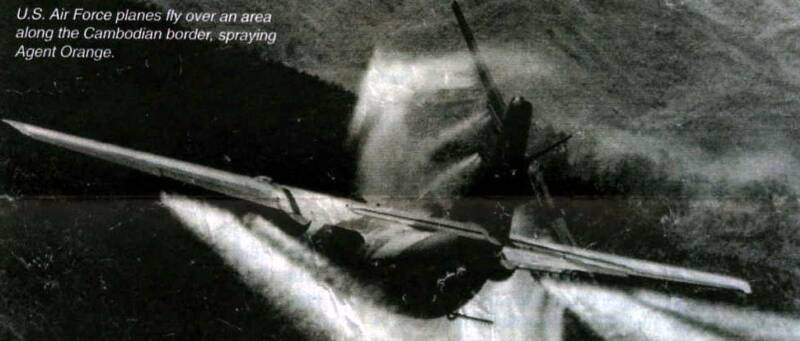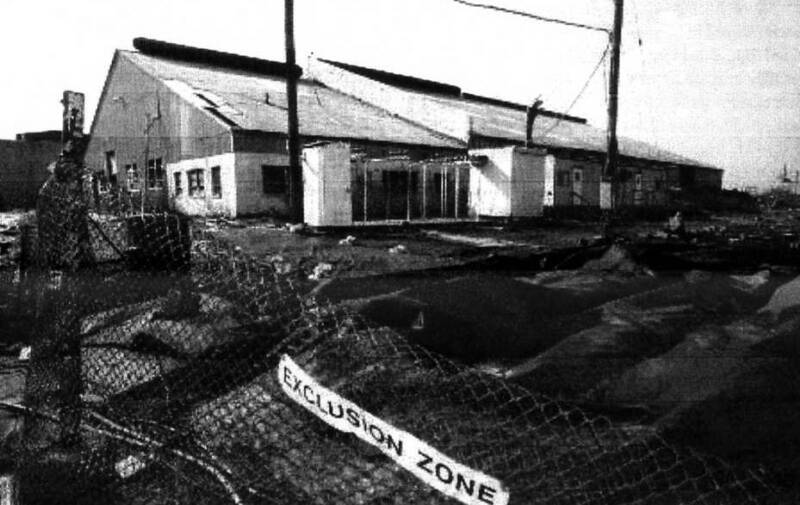

Agent Orange: Legacy of Disability
Veterans Health
By Thorn. Wilborn
Soldiers who served in Vietnam tell of the red liquid dripping from jungle leaves they brushed by while on patrol. Sometimes their uniforms would be soaked with the sluff. Today. the reddish-brown liquid known as Agent Orange used to defoliate trees and reimne jungle cover from the enemy in Vietnam is responsible for a wide range of illnesses, causing disability and death to thousands of veterans.
"An estimated 21 million gallons of Agent Orange and oilier herbicides were sprayed -over South Vietnam and Cambodia between January 1965 and April 1970," said National Service Director Randy Reese. "The Department of Veterans Affairs estimates thai 2.<i million U.S. military personnel were affected, causing disabling and life-threatening illnesses that still are not fully understood."
Some Vietnam veterans reported a variety of health problems soon after
reluming from the war. and others are just now experiencing the ill effects of their exposure. Agent Orange was a 50:50 mixture of 2.4.5-trichlorophe-noxyacetic acid (2.4.5-T) and 2,4-dichlorophenoxyacetic acid (2.4-D). At the time it was sprayed, 2.3,7,8-Ietrachlorodiben7o-p-dioxin (TCDD) was an unintended contaminant from the production of 2.4.5-T. and was present in Agent Orange and other formulations sprayed in Vietnam. Dioxin is one the deadliest cancer-causing chemicals known.
Skeptical federal authorities acknowledged a possible problem in 1978. when the VA offered Vietnam veterans special access to health care and launched a nearly endless series of studies by beginning the Agent Orange Registry-Examination Program. It was a medical surveillance program tracking Vietnam veterans' health concerns. In 2003. after 25 years, the VA had examined 334,000 of 3.4 million veterans who served in Vietnam and maintains a computer database to track their health
concerns.
The VA's Advisory Committee on Health-Related Effects of Herbicides was established in 1979 to examine issues surrounding the possible health effects of herbicides on Vietnam veterans. The VA also established the Veterans" Advisory Committee on Em ironmentat Hazards, consisting of non-VA experts in dioxin and radiation exposure and lay members, to advise on the results of Agent Orange-related research and regulatory, administrative, and legislative initiatives. A federal law passed in 1991 directed the VA to request that the National Academy of Sciences (NAS) review diseases associated with herbicide exposure, a move that superseded the Advisory Committee's work.
The NAS reviewed more than 6,000 abstracts of scientific or medical articles and analyzed 230 long-term studies before making its initial report in July 1993, which led to presumptive service-connection for several health problems among veterans.
Today, the list of presumptive service-connected health problems caused by exposure to Agent Orange and other herbicides includes chloracne (a skin disease). Hodgkin's disease, multiple myeloma (a cancer of the blood cells]. non-Hodgkin's lymphoma, porphyria cutanea tarda (a skin disease caused by a defective liver enzyme), respiratory cancers (lung, bronchus, larynx, and trachea), soft-tissue sarcoma (cancer of the muscles and tendons), acme and subacute peripheral neuropathy (weakening of the nervous system), prostate cancer, chronic lymphocytic leukemia, and adult-onset (Type 2) diabetes.
In addition, the VA offers monetary benefits, health care, and vocational rehabilitation to the children of Vietnam veterans who suffer from spina bifida, a congenital birth defect of the spine.
The widespread use of Agent Orange makes presumptive service-connection for these health problems simple, all military personnel who served in Vietnam are considered to have been exposed to Agent Orange. The VA estimates that 10.000 Vietnam veterans have been disabled because of illnesses caused by exposure to Agent Orange and other herbicides used during the war. And officials estimate that more than 178,000 of the 2.6 million living Vietnam veterans might qualify for disability compensation and health care.
"The progress of Agent Orange research has been slow and incremental.' said Reese. "Large-scale research should continue to study the health problems of Vietnam veterans. Vietnam veterans are dying from diseases that today are not considered service-connected, but may someday be considered presumptive."
"Any Vietnam veterans who suspect they have been diagnosed with any of these diseases should contact their nearest DAV National Service Office to file a claim for benefits," he said. "Our National Service Officers arc ready to offer their outstanding free professional services to help veterans apply for and receive compensation and health care for the diseases associated with Agent Orange and other herbicide contamination."
Meanwhile many questions remain about Agent Orange and other herbicide contamination. House Veterans'Affairs Committee ranking member. Rep. Lane Evans (D-I1I.) asked the Department of Defense (DoD) aboui potential Agent Orange and other herbicide contamination of U.S. service members in Guam. Cambodia. Laos. Thailand. Puerto Rico, and several sites in the United States during the Vietnam years. Evans provided DoD with a report finding dioxin contamination in the soil at Anderson Air Force Base in Yieo. Guam.
The DoD says that some military personnel were exposed to chemical herbicides in the Korean Demilitarized Zone.
Principal Assistant Depulv Under Secretary of Defense tor Installations and Environment Philip W. Crone said DoD had no record of the use. storage, or testing of Agents Orange. Blue, or While on Guam. Although other herbicides may have passed through Guam during ihe Vietnam War. Crone said the dioxin found at the Guam base may have been associated with burned material. The site is today. however, highly restricted. A summary provided by Crone listed 48 reported uses of chemical herbicides at sites in the United States and overseas.
Meanwhile, it was reporied in Rep. Evans that nearly 250,000 pounds of Agent Orange accidentally spilled on Johnston Island in 1972 when about 1.1 million gallons of unused Agent Orange was brought there from Vietnam. An estimated 44,000 gallons of Agent Orange is estimated to have leaked annually from the drums at the Johnston Island storage site. The VA has consistently denied Agent Orange claims from veterans who served on
Johnsion Island from 1971 to 1977. unless they were directly involved in the handling of the herbicide.
Another area of questioned exposure to Agent Orange and other herbicides is Korea. The DoD says that some military personnel were exposed in chemical herbicides in the Korean Demilitarized Zone.
"It is more than 30 years since many of the herbicides were used, yet veterans are still having claims denied because of the lack of information concerning where veterans may have been exposed." said Fvans. "It is well past the time for full and open disclosure.
Agent Orange has been a Pandora's box for Vietnam veterans, said Reesc. "The more that is learned aboul herbicide contamination, the more we find it affects the health of our veterans. Even though the fighting ended 30 years ago, the causalities from the Vietnam War continue to mount. It is our duty to offer the best DAV services to help those veterans and their families."
Today, the list of presumptive service-connected health problems caused by exposure to Agent Orange and other herbicides includes chloracne (a skin disease), Hodgkin's disease, multiple myeloma (a cancer of the blood cells), non-Hodgkin's lymphoma, porphyria cutanea tarda (a skin disease caused by a defective liver enzyme), respiratory cancers (lung, bronchus, larynx, and trachea), soft-tissue sarcoma (cancer of the muscles and tendons), acute and subacute peripheral neuropathy (weakening of the nervous system), prostate cancer, chronic lymphocytic leukemia, and adult-onset (Type 2} diabetes.
Paul Marquis
Web Master
Jim Cannon
Veterans Rep & Historian
BACK TO CONTENTS PAGE

Heavy plastic covers the Dioxin-contaminated ground at a former production site for Agent Orange in Newark, N.J.

DoD says that some military personnel were exposed to chemical herbicides in the Korean Demilitarized Zone.
